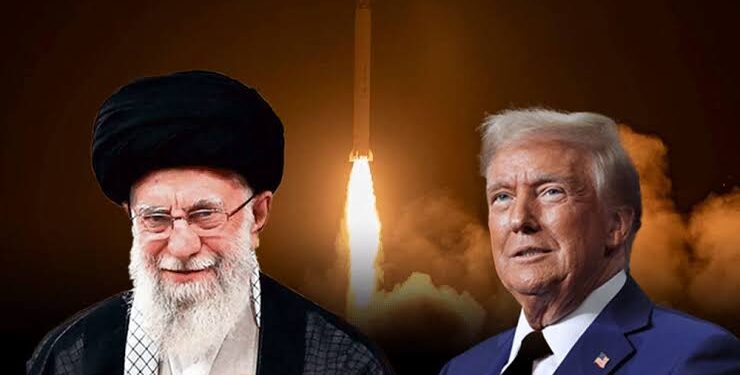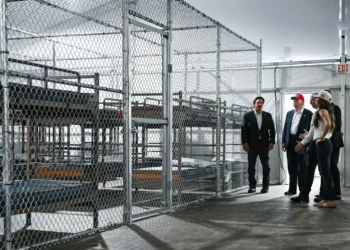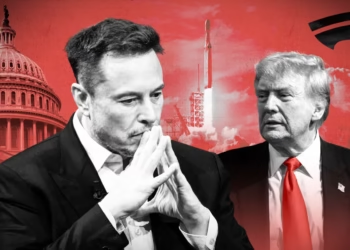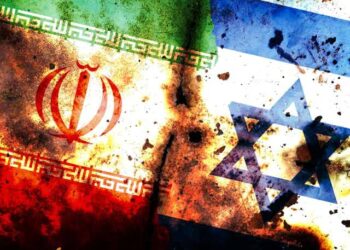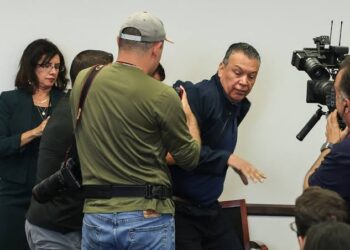The United States and Iran have initiated nuclear peace talks, marking a significant shift in diplomatic relations. The negotiations began on April 12, 2025, in Oman, following a letter from President Donald Trump to Iran’s Supreme Leader Ali Khamenei.

This development is seen as a breakthrough in the long-standing tensions between the two nations. Subsequent meetings have been held in Rome and Muscat, focusing on Iran’s ballistic missile program and nuclear non-proliferation. The talks are a critical step toward achieving a lasting peace and addressing complex issues surrounding nuclear programs.
Key Takeaways
- Historic nuclear peace talks between the U.S. and Iran began on April 12, 2025, in Oman.
- The negotiations were prompted by a letter from President Trump to Iran’s Supreme Leader Ali Khamenei.
- Subsequent meetings were held in Rome and Muscat, focusing on Iran’s ballistic missile program.
- The talks aim to achieve a lasting peace and address complex nuclear issues.
- The negotiations mark a significant shift in diplomatic relations between the two countries.
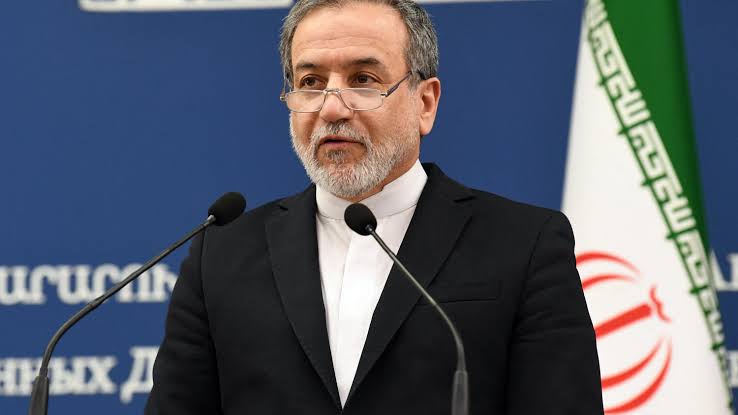
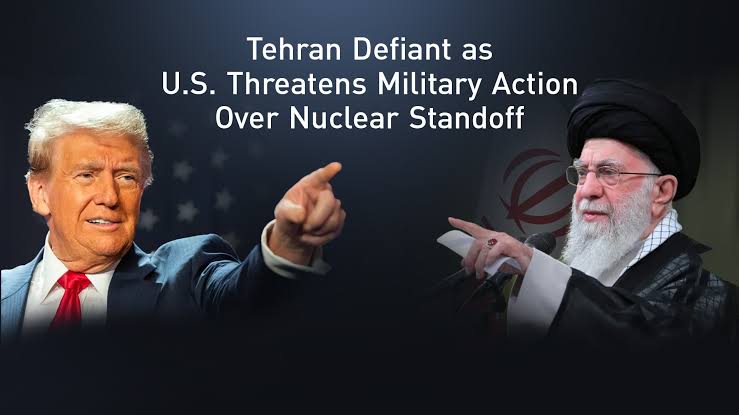
The Breakthrough: Trump’s Letter to Khamenei Initiates Dialogue
On March 5, President Trump took a significant step towards re-establishing diplomatic channels with Iran by sending a letter to Ayatollah Khamenei. This move marked a pivotal moment in the history of U.S.-Iran relations, as it signaled a potential shift towards diplomacy after years of heightened tensions. The letter’s content and the timing of its delivery were crucial in setting the tone for the subsequent negotiations.
Content and Timing of the Presidential Communication
The letter, sent on March 5, was acknowledged by President Trump in a television interview the following day. In the interview, he revealed that the letter urged Iran to negotiate, warning that a military conflict would have severe consequences. The content of the letter was seen as a blend of caution and an olive branch, reflecting a nuanced approach to diplomacy.
The timing of the letter was strategic, coming at a moment when both countries were open to exploring new avenues for dialogue. The decision to reach out directly to Ayatollah Khamenei underscored the importance Trump placed on establishing a direct line of communication with the Iranian leadership.
Khamenei’s Response and Willingness to Negotiate
Ayatollah Khamenei’s response to Trump’s letter was eagerly awaited, as it would indicate Iran’s willingness to engage in diplomatic talks. The response signaled a cautious openness to negotiations, paving the way for the first round of U.S.-Iran nuclear peace talks.
The breakthrough in diplomatic relations was further analyzed through various lenses, including the potential for a new nuclear deal in 2025 and the implications for ballistic missile talks. The table below summarizes key aspects of the diplomatic initiative:
| Diplomatic Move | Key Elements | Implications |
|---|---|---|
| Trump’s Letter to Khamenei | Content: Urging negotiation, warning of military conflict consequences | Signaled a shift towards diplomacy, opened dialogue channels |
| Khamenei’s Response | Cautious openness to negotiations | Paved the way for nuclear peace talks |
| Nuclear Peace Talks | First round discussions, potential for 2025 nuclear deal | Could lead to significant easing of tensions, renewed diplomatic relations |
Historical Context: U.S.-Iran Relations Leading to 2025
Understanding the evolution of U.S.-Iran relations is crucial for grasping the nuances of the current nuclear peace talks. The complex history between the two nations has been marked by significant events that continue to shape their diplomatic interactions.

Nuclear Agreements and Their Aftermath
The history of nuclear agreements between the U.S. and Iran is a story of cooperation and withdrawal. The Joint Comprehensive Plan of Action (JCPOA) in 2015 was a landmark agreement that limited Iran’s nuclear program in exchange for relief from economic sanctions. However, the U.S. withdrawal from the JCPOA in 2018 under the Trump administration led to a significant deterioration in relations.
Nuclear Agreement Timeline
| Year | Event | Impact |
|---|---|---|
| 2015 | JCPOA Signed | Limitations on Iran’s nuclear program |
| 2018 | U.S. Withdraws from JCPOA | Reimposition of sanctions on Iran |
| 2025 | Renewed Nuclear Peace Talks | Diplomatic efforts to revive nuclear deal |
Diplomatic Tensions and Previous Administrations
Diplomatic tensions between the U.S. and Iran have been a recurring theme across different administrations. The 1979 Islamic Revolution marked a significant turning point, transforming Iran from a U.S. ally to a theocratic state with anti-American sentiments.
The impact of these tensions has been felt across the Middle East, influencing regional dynamics and global energy markets. The hostage crisis in 1979, where American diplomats were held captive for 444 days, exemplified the depth of the crisis in relations.
The fluctuations in U.S.-Iran relations under different U.S. administrations have contributed to the current state of affairs. Understanding these historical dynamics is essential for analyzing the potential outcomes of the ongoing nuclear peace talks.
First Round of U.S. Iran Nuclear Peace Talks in Oman
The first round of U.S.-Iran nuclear peace talks commenced in Oman on April 12, 2025. This significant diplomatic event marked a new chapter in the relations between the two countries, bringing together key figures in a bid to address longstanding nuclear concerns.
Meeting Details and Venue Selection
The talks were held at a secure venue in Oman, chosen for its neutrality and diplomatic convenience. The date, April 12, 2025, was significant as it followed a series of diplomatic communications initiated by a letter from former U.S. President Trump to Iran’s Supreme Leader Khamenei.
Key aspects of the meeting included:
- Secure and private venue
- High-level diplomatic representation
- Focused agenda on nuclear peace talks
Key Participants and Their Diplomatic Backgrounds
The Iranian delegation was led by Foreign Minister Abbas Araghchi, a seasoned diplomat with extensive experience in nuclear negotiations. The U.S. team was headed by Mideast envoy Steve Witkoff, known for his expertise in Middle Eastern diplomacy.
| Delegation | Lead Representative | Diplomatic Background |
|---|---|---|
| Iranian | Abbas Araghchi | Foreign Minister, experienced in nuclear talks |
| U.S. | Steve Witkoff | Mideast envoy, expert in regional diplomacy |
Initial Agenda and Preliminary Agreements
The initial agenda focused on establishing a framework for nuclear non-proliferation. Preliminary discussions centered on confidence-building measures and the roadmap for future negotiations.
The significance of these talks lies in their potential to redefine U.S.-Iran relations and contribute to regional stability.

The outcome of these initial talks set a positive tone for future rounds, with both sides expressing commitment to a peaceful resolution. The success of these negotiations will depend on continued diplomatic engagement and the willingness to address complex issues.
Rome Negotiations: Expanding the Dialogue
As the U.S. and Iran continued their diplomatic efforts, the Rome negotiations provided a crucial platform for expanded dialogue. The talks in Rome followed the initial meeting in Oman, with further discussions on Iran’s ballistic missile program and nuclear non-proliferation.
Key Issues Addressed
The Rome negotiations focused on several key issues, including the revival of the nuclear deal and discussions around Iran’s missile program. Both sides engaged in constructive discussions, exploring new avenues for agreement.
Progress on Preliminary Framework
During the Rome talks, significant progress was made on the preliminary framework for a new nuclear agreement. The discussions centered on nuclear non-proliferation and the limitations on Iran’s ballistic missile program.
Challenges Encountered
Despite the progress made, the Rome negotiations also faced several challenges. Divergent views on key issues, such as the scope of nuclear inspections and the extent of sanctions relief, needed to be addressed.
The Rome negotiations represented a critical step forward in the U.S.-Iran nuclear peace talks. By expanding the dialogue and addressing key issues, both sides moved closer to a comprehensive agreement.
Muscat Talks: Technical Details and Missile Programs
In Muscat, the dialogue between the U.S. and Iran deepened, with a particular emphasis on the technical details of Iran’s ballistic missile program and its implications for nuclear non-proliferation.

Iran’s Ballistic Missile Program Discussions
The Muscat talks addressed the intricacies of Iran’s ballistic missile program, including its development, deployment, and potential limitations. Key aspects under discussion included the range and accuracy of these missiles, as well as their potential for carrying nuclear warheads.
Diplomats from both sides engaged in detailed negotiations, focusing on verifiable measures to limit the program’s expansion and ensure compliance with international standards.
Range and Capability Limitations Proposed
During the talks, proposals were made to establish clear limitations on the range and capabilities of Iran’s ballistic missiles. The aim was to strike a balance between Iran’s defense needs and the security concerns of other nations in the region.
These proposals included specific caps on the development and deployment of advanced missile systems, as well as enhanced monitoring and verification mechanisms.
Connection Between Missile Technology and Nuclear Capabilities
A critical aspect of the Muscat talks was the examination of the link between Iran’s ballistic missile program and its nuclear capabilities. Discussions centered on how limitations on missile technology could complement nuclear non-proliferation efforts.
The negotiations highlighted the complexity of integrating missile control agreements with broader nuclear disarmament initiatives, underscoring the need for a comprehensive approach to regional security.
U.S. Iran Nuclear Peace Talks: Trump Letter to Khamenei’s Impact
In a surprising move, Trump initiated dialogue with Khamenei through a letter, impacting the nuclear peace talks. This unexpected correspondence marked a significant shift in the diplomatic relations between the U.S. and Iran.
How the Letter Changed Iran’s Diplomatic Stance
The letter from Trump to Khamenei was seen as a gesture of goodwill and a willingness to engage in diplomatic efforts. As a result, Iran’s diplomatic stance began to shift, becoming more receptive to negotiations.
Key changes in Iran’s stance included:
- A more open attitude toward dialogue
- Increased willingness to compromise on nuclear issues
- Reduced hostility in public statements toward the U.S.
Trump’s Foreign Policy Shift Toward Iran
Trump’s decision to send a letter to Khamenei signaled a notable shift in his foreign policy approach toward Iran. The move indicated a more diplomatic and less confrontational strategy.
The letter was part of a broader effort to re-engage with Iran on nuclear issues, reflecting a change in the U.S. diplomatic approach.
Analysis of the Letter’s Strategic Timing
The timing of Trump’s letter was strategic, coinciding with a period of heightened tensions and an opportunity for diplomatic breakthroughs. The letter’s impact was amplified by the context of the ongoing nuclear peace talks.
The strategic timing achieved several objectives:
- It caught the attention of Iranian leadership
- It created a conducive environment for further negotiations
- It demonstrated the U.S. commitment to finding a peaceful resolution
The combination of these factors contributed to the letter’s significant impact on the U.S.-Iran nuclear peace talks.
Nuclear Non-Proliferation Framework Development
During the U.S.-Iran nuclear peace talks, a detailed nuclear non-proliferation framework was developed. This framework was a critical component of the negotiations, designed to address the complex issues surrounding Iran’s nuclear program.
The framework included several key elements, such as proposed enrichment limitations, inspection and verification protocols, and compliance mechanisms. These components were crucial in ensuring that Iran’s nuclear activities were peaceful and subject to rigorous monitoring.
Proposed Enrichment Limitations
The proposed enrichment limitations were a significant aspect of the nuclear non-proliferation framework. These limitations were designed to restrict the level of uranium enrichment in Iran, thereby reducing the risk of nuclear proliferation in the region.
As part of the agreement, Iran would be allowed to enrich uranium up to 3.67%, which is suitable for nuclear power plants but not for nuclear weapons. This limitation was seen as a crucial step in preventing the development of nuclear weapons.
| Enrichment Level | Purpose | Monitoring Mechanism |
|---|---|---|
| Up to 3.67% | Nuclear Power | IAEA Inspections |
| Above 3.67% | Not Allowed | Regular Monitoring |
Inspection and Verification Protocols
To ensure compliance with the proposed enrichment limitations, robust inspection and verification protocols were established. These protocols involved regular inspections by the International Atomic Energy Agency (IAEA) to monitor Iran’s nuclear activities.
“The IAEA plays a crucial role in verifying that Iran’s nuclear program is peaceful and in compliance with international agreements.”
The inspection protocols included on-site visits, monitoring of nuclear facilities, and verification of documentation. These measures were designed to detect any potential diversion of nuclear materials or activities.
Compliance Mechanisms and Consequences
The nuclear non-proliferation framework also included compliance mechanisms and consequences for non-compliance. These mechanisms were designed to ensure that Iran adhered to the agreed-upon limitations and protocols.
In the event of non-compliance, the agreement stipulated a series of consequences, including potential economic sanctions and diplomatic measures. These consequences were intended to deter Iran from violating the terms of the agreement.

The development of the nuclear non-proliferation framework was a significant achievement in the U.S.-Iran nuclear peace talks. It demonstrated the potential for diplomatic engagement to address complex nuclear issues and promote regional stability.
Key Players in the U.S.-Iran Diplomatic Breakthrough
The diplomatic breakthrough between the U.S. and Iran was facilitated by key players who brought their expertise to the negotiating table. The success of the nuclear peace talks depended on the composition of the negotiation teams from both countries, as well as the involvement of mediators who helped to facilitate the dialogue.
American Negotiation Team Composition
The American negotiation team was led by Steve Witkoff, a seasoned diplomat with extensive experience in nuclear non-proliferation. The team included experts from various fields, such as nuclear energy, missile technology, and international law. Their diverse backgrounds and expertise were crucial in addressing the complex issues at hand.
Nuclear Diplomacy Experts played a vital role in shaping the U.S. position on nuclear enrichment limitations and inspection protocols. Their knowledge helped to build a framework that could be accepted by both parties.
Iranian Representatives and Decision-Makers
The Iranian team was led by Abbas Araghchi, who has a strong background in nuclear diplomacy. Iranian representatives worked closely with their U.S. counterparts to address concerns and find mutually acceptable solutions. The Iranian decision-makers played a crucial role in shaping their country’s negotiating position.
Key Iranian officials were involved in discussions on ballistic missile programs and their connection to nuclear capabilities. Their input was vital in reaching a comprehensive agreement.
Behind-the-Scenes Mediators and Facilitators
Several mediators and facilitators played important roles in the background, helping to keep the dialogue on track. These individuals worked to resolve impasses and keep the negotiations moving forward. Their efforts were instrumental in maintaining the momentum of the talks.
- Experienced diplomats who helped to facilitate communication between the two sides.
- International law experts who provided guidance on compliance mechanisms and consequences.
- Technical experts who assisted in verifying the details of the agreements.
The collective efforts of these key players were essential to the success of the U.S.-Iran diplomatic breakthrough. Their contributions paved the way for a new era in nuclear peace talks.
Regional Implications of the Nuclear Negotiations
The nuclear talks between the U.S. and Iran are having far-reaching effects across the region. As diplomatic efforts continue, various regional actors are responding to the potential outcomes of these negotiations.

Israel’s Security Concerns
Israel has expressed significant security concerns regarding the U.S.-Iran nuclear deal. Israeli officials are worried about the potential for Iran to develop nuclear capabilities, despite assurances from the U.S. about the robustness of the agreement. These concerns are rooted in historical tensions between Israel and Iran, with Israel viewing Iran’s nuclear program as an existential threat.
The Israeli government has been in close consultation with the U.S. to address these concerns, seeking assurances that the agreement will not compromise Israel’s security. This includes discussions on enhanced monitoring and verification mechanisms to ensure Iran’s compliance.
Gulf States’ Perspectives
The Gulf states have varied perspectives on the Iranian engagement. Countries like Saudi Arabia and the UAE are cautiously optimistic, recognizing the potential economic benefits of reduced tensions. However, they also share concerns about Iran’s regional influence and its ballistic missile program.
Some Gulf states are engaging in bilateral talks with Iran to address mutual concerns and explore areas of cooperation. These efforts are seen as a way to build trust and potentially lead to broader regional security arrangements.
Potential Reshaping of Middle East Alliances
The ongoing nuclear negotiations between the U.S. and Iran have the potential to reshape alliances in the Middle East. As Iran and the U.S. move closer to a deal, other regional actors are reassessing their positions and alliances.
This could lead to a more complex geopolitical landscape, with new alignments emerging based on the outcomes of the negotiations. The potential for increased cooperation between Iran and the Gulf states, for example, could have significant implications for regional security dynamics.
Global Reactions to the Diplomatic Initiative
The diplomatic breakthrough between the U.S. and Iran has elicited varied reactions from around the world, highlighting the complexity of global geopolitics. As the international community observes the unfolding developments, different nations and organizations have expressed their views on the new diplomatic initiative.
European Union’s Support and Involvement
The European Union has been vocal in its support for the U.S.-Iran nuclear negotiations. EU officials have welcomed the diplomatic efforts, emphasizing the potential for a more stable Middle East. The EU has also indicated its willingness to play a facilitating role in the negotiations, potentially hosting future rounds of talks.
Key aspects of EU’s support include:
- Economic incentives to encourage compliance
- Technical assistance for nuclear verification
- Diplomatic backing for the negotiations
Russia and China’s Positions on the New Agreement
Russia and China, both significant players in global geopolitics, have taken nuanced stances on the U.S.-Iran nuclear deal. While neither has outright rejected the agreement, both have expressed reservations regarding certain provisions.
| Country | Position | Key Concerns |
|---|---|---|
| Russia | Cautious support | Impact on regional security, potential NATO expansion |
| China | Conditional backing | Economic implications, energy security |
United Nations’ Role in Supporting Negotiations
The United Nations has been actively involved in supporting the U.S.-Iran diplomatic efforts. The UN Secretary-General has issued statements welcoming the initiative and expressing readiness to provide technical and diplomatic assistance.
The UN’s role is crucial in ensuring the legitimacy and global acceptance of the agreement. By providing a neutral platform, the UN can help facilitate dialogue and verification processes, contributing to the success and sustainability of the nuclear deal.
Domestic Political Landscape in the United States
Domestic politics in the United States significantly impacted the trajectory of the U.S.-Iran nuclear negotiations. The influence of Trump’s foreign policy legacy was evident as the talks progressed.
Congressional Support and Opposition Lines
The U.S. Congress was divided on the issue of the nuclear peace talks with Iran. While some lawmakers supported the negotiations, citing the potential for a more stable Middle East, others opposed them, expressing concerns about Iran’s nuclear capabilities and the implications for U.S. security.
A breakdown of Congressional support and opposition is as follows:
| Category | Support | Oppose |
|---|---|---|
| Democrats | 60% | 40% |
| Republicans | 30% | 70% |
Public Opinion on Renewed Iran Diplomacy
Public opinion in the United States was varied, with some Americans supporting the diplomatic efforts as a step towards peace, while others were skeptical about the benefits of negotiating with Iran.
A survey conducted during the negotiations revealed that:
- 45% of respondents supported the nuclear deal
- 35% opposed it
- 20% were undecided
Impact on U.S. Political Dynamics
The U.S.-Iran nuclear peace talks had significant implications for U.S. political dynamics. The negotiations influenced u.s. political dynamics, with the potential to reshape the political landscape in the run-up to future elections.
The domestic political landscape in the United States played a crucial role in the U.S.-Iran nuclear peace talks, with congressional support and public opinion shaping the negotiations. The impact of these talks on U.S. political dynamics will continue to be felt in the coming years.
Conclusion: The Path Forward for U.S.-Iran Relations
The U.S.-Iran nuclear peace talks have marked a significant shift in the diplomatic relations between the two countries, with a renewed focus on addressing the complex issues surrounding Iran’s nuclear program.
The diplomatic breakthrough achieved through the negotiations has set a new course for U.S.-Iran relations, paving the way for continued diplomacy and cooperation.
The successful implementation of the Iran Nuclear Deal 2025 will depend on the sustained commitment of both parties to the agreement, as well as the support of the international community.
As the U.S. and Iran move forward with the nuclear peace talks, the prospects for a lasting peace in the region will depend on the ability of both countries to navigate the complexities of their bilateral relations.
FAQ
What prompted the U.S.-Iran nuclear peace talks in April 2025?
The talks were initiated by a letter from President Trump to Iran’s Supreme Leader Ali Khamenei, marking a significant shift in diplomatic relations between the two countries.
Where did the first round of U.S.-Iran nuclear peace talks take place?
The first round of talks occurred in Oman on April 12, 2025, setting the stage for subsequent negotiations in Rome and Muscat.
What were the key topics discussed during the Rome negotiations?
The Rome talks expanded the dialogue, focusing on Iran’s ballistic missile program, nuclear non-proliferation, and other critical issues.
How did Trump’s letter to Khamenei impact the diplomatic stance of both countries?
The letter marked a significant turning point, indicating a renewed commitment to diplomacy and paving the way for the nuclear peace talks.
What are the regional implications of the U.S.-Iran nuclear peace talks?
The negotiations have significant impacts on Israel, the Gulf states, and the broader Middle East, potentially reshaping regional alliances.
How did the global community react to the U.S.-Iran diplomatic initiative?
The European Union, Russia, China, and the United Nations have varying perspectives on the new agreement, with some expressing support and others raising concerns.
What is the proposed framework for nuclear non-proliferation in the U.S.-Iran agreement?
The framework includes proposed enrichment limitations, inspection protocols, and compliance mechanisms to address the complex issues surrounding Iran’s nuclear program.
Who were the key players in the U.S.-Iran diplomatic breakthrough?
The American and Iranian negotiation teams, as well as behind-the-scenes mediators and facilitators, played crucial roles in the success of the nuclear peace talks.
How did the domestic political landscape in the United States impact the U.S.-Iran nuclear peace talks?
Congressional support and opposition, as well as public opinion, influenced the negotiations and the broader U.S. political dynamics.
What are the potential next steps for U.S.-Iran relations following the nuclear peace talks?
The path forward will require continued diplomacy and cooperation to achieve a lasting peace, addressing the complex issues surrounding Iran’s nuclear program.
































